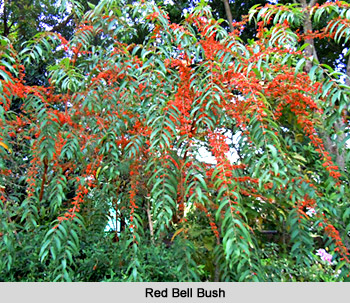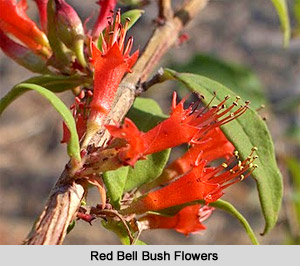 Being named as `Woodfordia Fruticosa` in science, the nice and beautiful `Red Bell Bush` is very common in the South Konkan and on the riversides and it climbs the Himalayas to 1500 m. However, it is rare in South India. This is a member of the family named `Lythraceae`. It is called as `Dawa` and `Santha` in Hindi. It is very small in size and is a type of spreading shrub that bears adequate leaves.
Being named as `Woodfordia Fruticosa` in science, the nice and beautiful `Red Bell Bush` is very common in the South Konkan and on the riversides and it climbs the Himalayas to 1500 m. However, it is rare in South India. This is a member of the family named `Lythraceae`. It is called as `Dawa` and `Santha` in Hindi. It is very small in size and is a type of spreading shrub that bears adequate leaves.
From the months of December to May, the shrub becomes very easily noticeable on the dry, rocky hillsides. During this period, the ample of little blazing bells give a brilliant touch of colour to the monotonous terrain of the shrub. The shrub sheds its foliage at the end of the year. Usually, it contains a very crimped stem. The bark of the `Red Bell Bush` is exceptionally slim and it sheds off in flakes. The shrub has a twiggy and formless appearance when it is in flower. It remains entirely sheathed in red colour at this time. The main reason behind this is that the small flowers of the shrub grow singly or in groups all the way along the branches and side twigs. The leaves also fall down at the same time.
 Each of the flowers of the shrub is a slender tube and it appears on a tiny stem. The flowers are slightly rounded and their greenish base is the calyx. The tube swells slightly and divides into slender, pointed lobes. A bunch of long stamens also emerges from this tube. The flowers of the `Red Bell Bush` never exceed the length of 2 cm including the stamens. The fruit is a little, square capsule and it remains covered by the withered calyx. The leaves of the shrub are slender and pointed. They grow straight from the branches, either in opposite position or in whorls of three. They are rough and dreary and dark green in colour. They are also paler and sometimes dotted with some small, black glands underneath. From the flowers contain a large amount of tannin. People can obtain a red dye from them and use it to dye silks. The leaves of the shrub also contain a large proportion of tannin and make the commonest tan in India.
Each of the flowers of the shrub is a slender tube and it appears on a tiny stem. The flowers are slightly rounded and their greenish base is the calyx. The tube swells slightly and divides into slender, pointed lobes. A bunch of long stamens also emerges from this tube. The flowers of the `Red Bell Bush` never exceed the length of 2 cm including the stamens. The fruit is a little, square capsule and it remains covered by the withered calyx. The leaves of the shrub are slender and pointed. They grow straight from the branches, either in opposite position or in whorls of three. They are rough and dreary and dark green in colour. They are also paler and sometimes dotted with some small, black glands underneath. From the flowers contain a large amount of tannin. People can obtain a red dye from them and use it to dye silks. The leaves of the shrub also contain a large proportion of tannin and make the commonest tan in India.



















